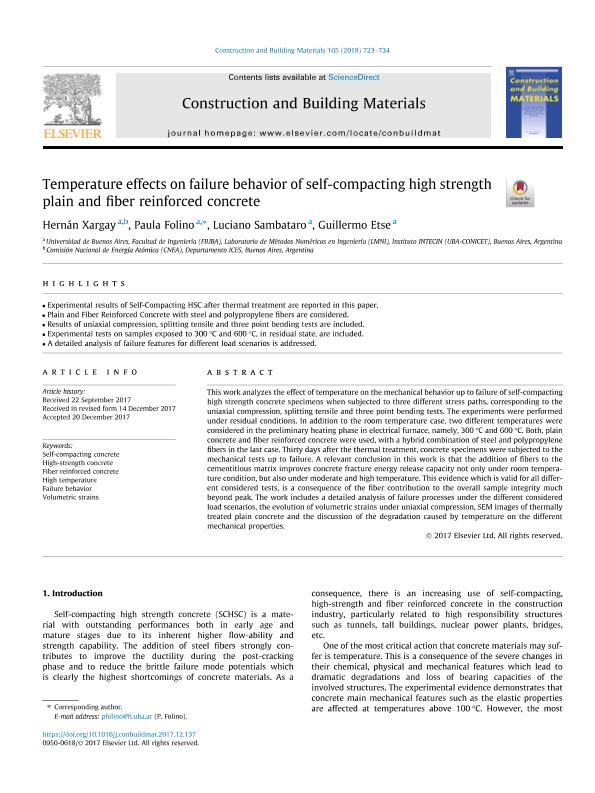Mostrar el registro sencillo del ítem
dc.contributor.author
Xargay, Hernan Daniel

dc.contributor.author
Folino, Paula

dc.contributor.author
Sambataro, Luciano
dc.contributor.author
Etse, Jose Guillermo

dc.date.available
2019-08-12T14:40:21Z
dc.date.issued
2018-03
dc.identifier.citation
Xargay, Hernan Daniel; Folino, Paula; Sambataro, Luciano; Etse, Jose Guillermo; Temperature effects on failure behavior of self-compacting high strength plain and fiber reinforced concrete; Elsevier; Construction And Building Materials; 165; 3; 3-2018; 723-734
dc.identifier.issn
0950-0618
dc.identifier.uri
http://hdl.handle.net/11336/81411
dc.description.abstract
This work analyzes the effect of temperature on the mechanical behavior up to failure of self-compacting high strength concrete specimens when subjected to three different stress paths, corresponding to the uniaxial compression, splitting tensile and three point bending tests. The experiments were performed under residual conditions. In addition to the room temperature case, two different temperatures were considered in the preliminary heating phase in electrical furnace, namely, 300 °C and 600 °C. Both, plain concrete and fiber reinforced concrete were used, with a hybrid combination of steel and polypropylene fibers in the last case. Thirty days after the thermal treatment, concrete specimens were subjected to the mechanical tests up to failure. A relevant conclusion in this work is that the addition of fibers to the cementitious matrix improves concrete fracture energy release capacity not only under room temperature condition, but also under moderate and high temperature. This evidence which is valid for all different considered tests, is a consequence of the fiber contribution to the overall sample integrity much beyond peak. The work includes a detailed analysis of failure processes under the different considered load scenarios, the evolution of volumetric strains under uniaxial compression, SEM images of thermally treated plain concrete and the discussion of the degradation caused by temperature on the different mechanical properties.
dc.format
application/pdf
dc.language.iso
eng
dc.publisher
Elsevier

dc.rights
info:eu-repo/semantics/openAccess
dc.rights.uri
https://creativecommons.org/licenses/by-nc-sa/2.5/ar/
dc.subject
Self-Compacting Concrete
dc.subject
High-Strength Concrete
dc.subject
Fiber Reinforced Concrete
dc.subject
High Temperature
dc.subject
Failure Behavior
dc.subject
Volumetric Strains
dc.subject.classification
Ingeniería de la Construcción

dc.subject.classification
Ingeniería Civil

dc.subject.classification
INGENIERÍAS Y TECNOLOGÍAS

dc.title
Temperature effects on failure behavior of self-compacting high strength plain and fiber reinforced concrete
dc.type
info:eu-repo/semantics/article
dc.type
info:ar-repo/semantics/artículo
dc.type
info:eu-repo/semantics/publishedVersion
dc.date.updated
2019-08-07T14:07:25Z
dc.journal.volume
165
dc.journal.number
3
dc.journal.pagination
723-734
dc.journal.pais
Reino Unido

dc.journal.ciudad
Amsterdam
dc.description.fil
Fil: Xargay, Hernan Daniel. Universidad de Buenos Aires. Facultad de Ingeniería. Laboratorio de Métodos Numéricos en Ingeniería; Argentina
dc.description.fil
Fil: Folino, Paula. Universidad de Buenos Aires. Facultad de Ingeniería. Laboratorio de Métodos Numéricos en Ingeniería; Argentina
dc.description.fil
Fil: Sambataro, Luciano. Consejo Nacional de Investigaciones Científicas y Técnicas. Oficina de Coordinación Administrativa Houssay. Instituto de Tecnologías y Ciencias de la Ingeniería "Hilario Fernández Long". Universidad de Buenos Aires. Facultad de Ingeniería. Instituto de Tecnologías y Ciencias de la Ingeniería "Hilario Fernández Long"; Argentina
dc.description.fil
Fil: Etse, Jose Guillermo. Consejo Nacional de Investigaciones Científicas y Técnicas. Centro Científico Tecnológico Conicet - Tucumán; Argentina. Universidad Nacional de Tucumán. Facultad de Ciencias Exactas y Tecnología. Centro de Métodos Numéricos y Computacionales en Ingeniería; Argentina
dc.journal.title
Construction And Building Materials

dc.relation.alternativeid
info:eu-repo/semantics/altIdentifier/url/https://www.sciencedirect.com/science/article/pii/S0950061817325424
dc.relation.alternativeid
info:eu-repo/semantics/altIdentifier/url/https://doi.org/10.1016/j.conbuildmat.2017.12.137
Archivos asociados
